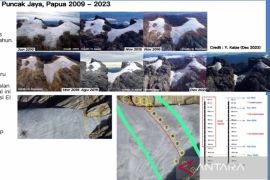"The local community named the cave as Kalabus Cave," Hari Suroto, an archaeologist of the Papua Center for Archaeology, stated during a telephonic conversation here on Sunday.
Suroto said the cave is located 200 meters west of the Kalabu River. When it was discovered, the caves floor was covered by the droppings of swallows, while the mouth and yard of the cave were in dry condition.
"Pottery and food remains, in the form of sea shells, were found on the floor of the caves mouth," he noted.
Based on the artifacts discovered in the cave, it could be assessed that Kalabus Cave had served as a prehistoric dwelling, as the men who once inhabited the cave largely depended on natural resources in the vicinity.
"The findings of food remains, in the form of sea shells, indicated that the men who once lived in the cave reached the coast in search of food," he revealed.
The finding of pottery artifacts also indicated that food processing activities were more varied, which included boiling.
"In addition, the pottery was used to store food or water," he noted.
Furthermore, Suroto, who was also an alumnus of the University of Udayana in Bali Province, said the observation results of the soil type around Kalabus Cave revealed that it could not have been used to make pottery. Hence, it could be assumed that the pottery came from outside the cave.
"Physically, Kalabus Cave is comfortable and safe, as it has spacious spaces, good lighting, dry and flat floor surface, good air circulation, and is located close to a water source," he stated.
"Kalabus Cave had the potential to be used as a place to live and move by humans," he added.(*)
Editor: Heru Purwanto
Copyright © ANTARA 2017











